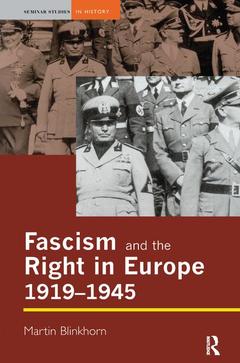Description
Fascism and the Right in Europe 1919-1945
Seminar Studies Series
Language: English
Subject for Fascism and the Right in Europe 1919-1945:
Keywords
italian; fascist; movement; italy; christian; social; party; marcel; deat; generic; Victor Emmanuel III; Jeunesses Patriotes; Mosley's BUF; Croix De Feu; LTS; BUF; Bloque Nacional; Adolf Hitler; Primo De Rivera Dictatorship; Italian Fascist Movement; Italian Fascist Regime; Fascist Movement; Christian Social Party; Generic Fascism; Italian Fascism; Young Men; Genuine Liberals; Ani; Corneliu Codreanu; Dollfuss Schuschnigg Regime; Oficial Del Estado; National Fascist Party; Fascism's Relationship; pre-Civil War Spain; Karlis Ulmanis
Publication date: 04-2016
· 15.6x23.4 cm · Hardback
Publication date: 10-2000
192 p. · Paperback
Description
/li>Contents
/li>Readership
/li>Biography
/li>Comment
/li>
This new text places interwar European fascism squarely in its historical context and analyses its relationship with other right wing, authoritarian movements and regimes. Beginning with the ideological roots of fascism in pre-1914 Europe, Martin Blinkhorn turns to the problem-torn Europe of 1919 to 1939 in order to explain why fascism emerged and why, in some settings, it flourished while in others it did not. In doing so he considers not just the 'major' fascist movements and regimes of Italy and Germany but the entire range of fascist and authoritarian ideas, movements and regimes present in the Europe of 1919-1945.
- While recognizing the important distinctions that need to be made between different forms of right-wing extremism, Martin Blinkhorn also argues that the existence on the interwar right of shared ground, selective borrowing, and pragmatic compromise often made those distinctions less important in practice than they appeared in theory.
- Following a discussion of ways in which, since the 1920s, fascism has been understood and defined by a variety of political propagandists, social scientists and historians, the author offers his own conclusions as to how 'fascism' may best be understood, some 'turn-of-the-century' reflections on contemporary neo-fascism and 'post-fascism', and a unique 'template' against which the development of fascist and authoritarian ideas, movements and regime
These books may interest you

The Nature of Fascism 160.25 €



